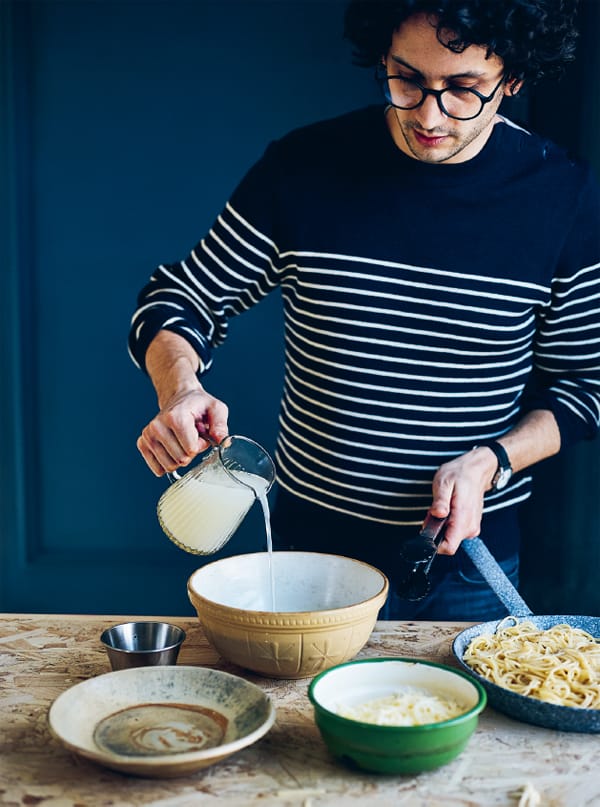
Comfort food Italian style, except I’ve made it French. Spaghetti, pici, tonarelli, linguine... you could use almost any type of pasta for this recipe but go for round shapes rather than flat ones. The challenge is to transform a hard and dry cheese into a silky, smooth sauce – which I’m here to show you how to do.
Serves 4
300g [10½oz] pasta of your choice
150g [1½ cups] grated Comté cheese at room temperature, plus a little extra to serve
freshly ground or cracked black pepper
Cook the pasta in a wide, deep pan, as you would for making a risotto. You want just enough salted water in the pan to cover the pasta. Using just a little water increases the amount of starch it contains from the pasta, which will make producing a smooth sauce easier later.
After 5 minutes of cooking the pasta, transfer 225ml [1 cup] of the cooking water to a separate bowl and replace it in the pan with fresh boiling water. Finish cooking the pasta according to the instructions on the packet.
Put the grated cheese and 4 grinds of black pepper in a large dish and very slowly beat in the water drained from the pasta, as though you wanted to make a mayonnaise. The idea is to achieve a syrupy sauce.
Add the drained pasta and mix well, making sure every piece of pasta is coated in sauce. Add a little more of the cooking water from the pasta if necessary.
Serve at once with a little more cheese sprinkled over each serving and a final grind of the pepper mill.
GOOD TO KNOW
I’ve used the French cheese Comté for this recipe. You can find it pretty much everywhere but if you have trouble tracking it down or you’re feeling frugal (in French, when you don’t want to spend much money, we say ‘if you have sea urchins in your pockets’ – ouch!, you can of course use any hard cheese such as Parmesan, Grana Padano, Pecorino...)
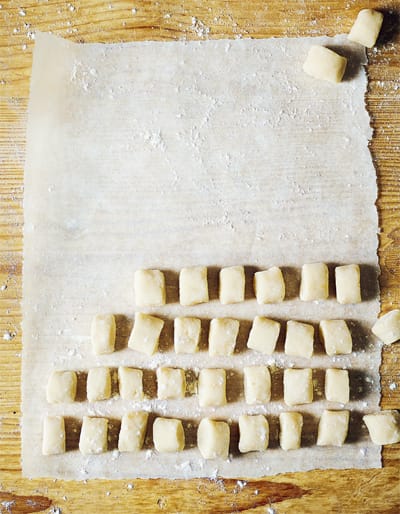
This recipe came about because I don’t always have potatoes at home but I do have a packet of instant potato flakes – they’re super for making mash for my son and his fantastic dad me!. I’ve included 4 tasty butters to up the gnocchi’s ‘wow’ factor.
Serves 4
125g [1 cup] plain [all-purpose] flour, plus extra for rolling out
200g [2 cups] instant potato flakes
1 egg, beaten
225ml [1 cup] water
½ tsp fine sea [kosher] salt
salted butter or one of the flavoured butters opposite, to serve
Put the flour and potato flakes in a large bowl and stir to mix. Make a well in the centre and pour in the egg and water and add the salt. Stir everything together to make a soft, smooth dough, dust the worktop lightly with flour and roll the dough into long cylinders, about 2cm [¾in] in diameter with your hands. Cut into roughly 2-cm [¾-in] lengths with a knife. We call these ‘small pillows’ in French – yes, really.
Cook the dough pieces in a saucepan of boiling water for about 2 minutes – when they float they are ready. Drain and serve hot tossed with salted or flavoured butter. These gnocchi are one of the most comforting dishes I know. You can even serve them cold without butter and they’re still pretty good to eat.
Now here’s a confession: French fries aren’t French. They actually come from Belgium and I have to say the Belgians are extremely good at making them. Crispy on the outside, fluffy on the inside, and beautifully golden, they’re absolutely nothing like the limp, barely-cooked sticks you find all the time in fast food places.
Serves 4
1kg [2lb 4oz] large potatoes, e.g. Maris Piper, Sebago, Bintje, Russet
groundnut [peanut] oil for deep-frying
3 Tbsp butter
3 Tbsp plain [all-purpose] flour
about 350ml [1½ cups] dark beef stock
salt
60g [about ½ cup] white Cheddar cheese curds or chunks of semi-dry mozzarella
Peel the potatoes and cut them into sticks, 1cm [½in] thick. If they’re too thin, they’ll overcook when you fry them and if they’re too thick, they’ll be raw in the centre… Just saying.
Pour the oil into a large, heavy-based saucepan or deep-fryer – but don’t fill the pan more than half-full – and heat the oil to 130ºC [270ºF]. It’s important to use a cooking thermometer and to check it regularly to make sure the oil is at just the right temperature.
Fry the potatoes in batches for 7–10 minutes or until they are tender when pierced with a skewer or the tip of a knife but they haven’t started to colour. Drain each batch onto a plate lined with kitchen paper [paper towels] before you add the next to the pan.
Heat the butter in a saucepan over a medium heat. When melted, take the pan off the heat and stir in the flour until smooth and then cook until the mixture becomes caramel-coloured. Gradually stir in the stock and bring to the boil, stirring constantly until smooth and syrupy – the amount of stock you add will depend on how thick you want your sauce to be. Instant gravy – done.
Keep the gravy warm over a low heat while you finish frying the chips. Reheat the oil to a higher temperature this time – 180ºC [350ºF] – to ensure the fries are really crisp. Fry all the potatoes in one go until they are done to your liking – personally I prefer them brown rather than golden so in my case I’d do this for 4 minutes but you might prefer yours golden, so reduce the frying time a bit. Drain as above and immediately sprinkle the fries generously with salt.
Divide the fries between serving bowls, scatter over the cheese and spoon over the hot gravy.
Another confession
La poutine is a Canadian dish from Quebec so, as far as I can see, there’s nothing very French about this recipe...
This recipe might have been called: ‘How to finally master the art of cooking basmati rice, make it really colourful and pretty with saffron, and add different sweet and savoury textures’. I then said to myself ‘maybe that’s a bit long for a title’ but it does tell you everything you need to know.
Serves 4
350g [1¾ cups] of the best basmati rice you can buy
12 saffron threads
1 large orange
50g [2oz] shelled unsalted pistachios
2 Tbsp dried barberries (or chopped sour cherries)
Put the rice in a large bowl and pour over enough cold water to cover. Stir with your hand and when the water becomes cloudy, replace it with fresh. Repeat this process at least 3 times. “Why?”, you ask. Well, it’s a fair question. The reason is that by soaking and rinsing the rice, you get rid of the natural starch it contains that makes the grains stick together as they cook. So – OK – when you’re making a risotto, you don’t rinse the rice. Get it?
Cover the rice with fresh water one last time and let it soak for 20 minutes. Drain in a colander and run cold water through to rinse it. Tip the rice into a saucepan and add 900ml [3¾ cups] cold water.
Crush the saffron threads and place in a small, heatproof jar. Add 2 tablespoons of boiling water and screw the lid on the jar.
Bring the rice to the boil, lower the heat, put a lid on the pan and stand the warm, sealed jar on top. Leave the jar there while simmering the rice for 10–12 minutes. Now remove the jar, leave the lid on the pan and let the rice sit for 5 minutes. Finally, lightly fork through the grains to fluff them up.
Transfer half the cooked rice to a bowl and pour in the infused saffron. Stir gently with a fork until the liquid from the saffron has been absorbed by the rice.
Using a speed [swivel] peeler, shave the zest from the orange in wide ribbons and then cut these into very fine strips. Chop the pistachios.
Spoon the white rice and yellow rice into a shallow dish and add half the strips of orange zest, half the pistachios and half the barberries. Stir gently to mix everything together, but without crushing the rice grains, and scatter over the remaining orange zest, pistachios and barberries.
A CONFESSION
Although this recipe might dazzle with its rich colours and textures, it happens that some evenings I have nothing to add to my bowl of rice. So, what do I do then? Well, I just enjoy the gentle heat coming from the bowl, the natural beauty of the long grains of rice, each one beautifully separate, and the delicate perfume of butter that I’ve gently heated until it melts before drizzling over the rice.
Make the gratin 24 hours ahead and reheat when you want to serve it as it will be even better. This is due to a complex alchemy developing between the potatoes and the cream, which changes the structure of the gratin, making it firmer and the layers more even.
A dish from my childhood that brings back all kinds of happy memories and reminds me of the comfort and warmth of home. My mother would prepare the gratin in a large oval dish and, ever since, I’ve always made mine in a large oval dish as well – but a red one. I have an awful lot of trouble understanding why people persist in preparing their gratin in a rectangular dish and, even worse, one that’s blue.
Serves 6–8
about 10 medium-sized, firm-fleshed, waxy potatoes (don’t use floury ones), total weight about 1.5kg [3lb 5oz], peeled
salt and pepper
450ml [2 cups] whole milk
450ml [2 cups] double [heavy] cream
1 bay leaf
pinch of freshly grated nutmeg
40g [about 1/3 cup] grated cheese, e.g. Parmesan, Cheddar, Comté (strictly speaking, the cheese is optional… But is it really?)
Cut the potatoes into 5-mm [¼-in] thick slices. Don’t wash them as it’s their starch that is going to thicken the sauce. Season the slices with salt and pepper.
Put the potatoes in a saucepan, add the milk, cream and bay leaf and simmer gently for about 10 minutes. Lift out the potatoes with a slotted spoon into a bowl and set them aside. Season the milk and cream with the nutmeg and, if necessary, salt and pepper. Discard the bay leaf.
Preheat the oven to 180ºC/160ºC fan/350ºF/Gas 4.
Layer the potato slices and cream mixture alternately in a greased ovenproof dish, seasoning lightly between the layers.
Bake in the oven for 40–45 minutes or until the potatoes are tender when pierced with a skewer or the tip of a knife. Take the dish out of the oven and switch on the grill [broiler]. Sprinkle over the grated cheese and grill until the top is golden and crusty.
VEGAN ALTERNATIVE
By replacing the cream with coconut cream and the milk with almond milk, plus 1 teaspoon of cornflour (cornstarch) – but following pretty much the same steps – you get a decent dairy-free alternative that’s not just fine for vegans but is also lighter. There are plenty of vegan cheeses to choose from for the crispy topping.
This is my version of an American classic but, of course, I’ve given it a French twist. I know a traditional mac’n’cheese must be rich and creamy all the way through but this one has a crusty topping. Sigh. I admit I’m breaking all the rules but as it’s not the only time I’ll be doing that in this book, I don’t feel too bad about it.
Serves 6
400g [3½ cups] elbow macaroni
3 Tbsp salted butter
3 Tbsp plain [all-purpose] flour
450ml [2 cups] cold whole milk
1 egg yolk
400g [4 packed cups] grated cheese, e.g. Cheddar, Emmental, Fontina, Colby
salt and pepper
pinch of grated nutmeg (OK, I know I’ve lost it)
mushrooms, optional (thank goodness for that)
pinch of thyme (are you kidding?)
Cook the macaroni in a saucepan of boiling, salted water for at least 2 minutes less than the time indicated on the packet. Drain and set aside.
Add the butter and flour to the saucepan. Stir for a few minutes over a medium heat with a spatula until you have a smooth paste, but without letting the mixture colour.
Add the milk, a little at a time, stirring constantly until the sauce comes to the boil and is thickened and smooth. Take the pan off the heat, mix the egg yolk with a little of the sauce and stir this back into the rest of the sauce in the pan. Add three-quarters of the grated cheese, mix it in and then season with salt, pepper and nutmeg.
Give yourself a pat on the back as you have just made a genuine fancy-schmancy French classic called Mornay Sauce – so how about that?
Preheat the oven to 200ºC/180ºC fan/400ºF/Gas 6. Cut the mushrooms into small pieces, if using.
Mix together the slightly under-cooked macaroni, the sauce, thyme and mushrooms and spoon into a large gratin dish. Sprinkle over the rest of the grated cheese and bake in the oven for 20 minutes until crispy on top and melting and creamy underneath.
I make this recipe, or a variation of it, at least once a week. I vary it according to what I have to hand in the fridge but the method is always more or less the same. So here it is...
Serves 2
For an instant sauce
1 tsp soy sauce
1 tsp water
a few drops of Shaoxing wine
a few drops of sesame oil
For the fried rice
2 Tbsp neutral flavoured oil
1 egg, beaten
2 bacon rashers [slices], cut into lardons
75g [½ cup] raw prawns [shrimp], chopped
2-cm [¾-in] piece of root ginger, peeled and grated
1 garlic clove, crushed
125g [1 cup] cooked long-grain rice
3 Tbsp peas or chopped courgettes [zucchini] or celery (or any cooked green veg, chopped or sliced, if necessary)
To serve
1 spring onion [scallion], finely chopped
a pinch of chilli flakes
Make the sauce by mixing all the ingredients together.
For the fried rice, heat 1 tablespoon of the oil in a large frying pan [skillet] or wok over a very high heat. Before the pan becomes too hot, pour the beaten egg into it and stir until scrambled and just set. Scrape the egg out of the pan onto a plate and set aside. Add the remaining oil to the pan and briefly stir-fry the bacon and prawns. Before the bacon starts to brown, add the ginger and garlic, followed by the rice, and stir-fry briskly for 2 minutes.
Add the peas (or whichever green veg you’re using), the scrambled egg and the sauce. Stir-fry for 1 minute or until everything is piping hot. Divide between 2 plates or bowls and serve at once sprinkled with the chopped spring onion and a dusting of chilli flakes.
Talking about rice...
Leftover rice from the night before is always a bit dry, which is normally a pain but here it’s a plus. Let me explain. The enemy of caramelization is water so rice that is a little dry will caramelize and become crisp more quickly than rice that is freshly cooked and therefore still full of water. This recipe is a great way to use up leftover rice, but to avoid a potentially nasty bout of food poisoning, put it in the fridge as soon as it’s cool; if the rice is left sitting around at room temperature, any bacteria it contains will begin to grow and multiply. Use the rice the next day and make sure it’s piping hot and steaming before you serve it.
6 French cheeses and 21 alternatives from around the world
A cheese board really is the most satisfying experience you can possibly share on special occasions with your friends and family. Here is a selection of six very different but equally iconic French cheeses... BUT WAIT! Since I know that most of you won’t have easy access to them, I’m also giving you some alternatives from around the world.

Comté
Strength: 2 out of 5
Stinky-ness: 1 out of 5
Smooth and semi-hard, sometimes crumbly. A pressed and cooked cheese made from cow milk that is produced in eastern France in the Jura mountains. Comté is aged for at least 4 months but more likely for about 8 months (the bigger the rind, the more mature the cheese). It has mild, milky, caramelized and toasted aromas with a hint of spice like nutmeg.
World alternatives Swiss Gruyère; young British Cheddar; Wisconsin Pleasant Ridge Reserve; Vermont Tarentaise
Roquefort (you don’t pronounce the ‘t’)
Strength: 5 out of 5
Stinky-ness: 4 out of 5
Sharp and buttery flavour. An unpressed and uncooked crumbly cheese made from full-fat sheep milk in south-west France or, more precisely, the Aveyron region. It belongs to the blue cheese family, is marbled throughout with blue-ish penicillium veins, which give it a distinct, pungent smell.
World alternatives Italian Gorgonzola; British Blue Stilton; Danish Blue; or even Iowa Blue Maytag
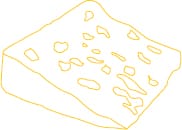
MYTH BUSTER – does cheese really stink?
When smelling a cheese, most of us fight the sensations coming from our nose, which inevitably makes the mind shut down and prevents the experience being enjoyable! The truth is cheese doesn’t really stink; it just smells strong. So, the answer to my question is ‘no’. (Unless, of course, we’re talking Epoisses, in which case YES, cheese definitely does stink! Does that make sense?)

Strength: 2 out of 5
Stinky-ness: 2 out of 5
Semi-hard, smooth and mild. A pressed and uncooked cheese made from sheep milk from the Pyrenees in south-west France. As soon as you unwrap it, you immediately get the funky sheep vibe but generally it smells quite fresh and nutty.
World alternatives Spanish Manchego; young Italian Pecorino; US Gran Queso from Wisconsin

Crottin
Strength: 3 out of 5
Stinky-ness: 3 out of 5
Small soft-ripened cheese made from goat milk. The rind is quite thin but covered with an intricate pattern of wrinkles, making it beautiful, like a maze. Inside, it’s whiter and usually has two distinct textures – creamy and chalky.
World alternatives Italian Robiola di Capra; Bonne Bouche from Vermont; Californian Humboldt Fog
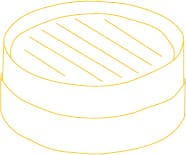
Epoisses
Strength: 2 out of 5
Stinky-ness: 5 out of 5
Brick coloured with a soft and creamy texture. A washed-rind cheese (they use brandy liquor) made from cow milk in Burgundy in central France. Its flavour is the direct opposite of its smell, as inside it’s rich and velvety.
World alternatives
Irish Ardrahan; German Limburger; British Stinking Bishop; Italian Taleggio
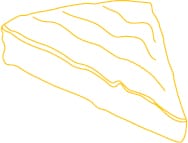
Brie
Strength: 2 out of 5
Stinky-ness: 2 out of 5
A smooth soft-ripened cheese made from cow milk with a fluffy, white, marbled rind. The inside can vary from crumbly to creamy, depending on its age. It has the aroma of fresh mushrooms but closer to cultivated than foraged fungi.
World alternatives Since Brie is produced all over the world, tracking it down won’t be a problem. To name but a few: King Island Dairy Brie from Australia; Cornish Brie from the UK; any Brie made in the US.